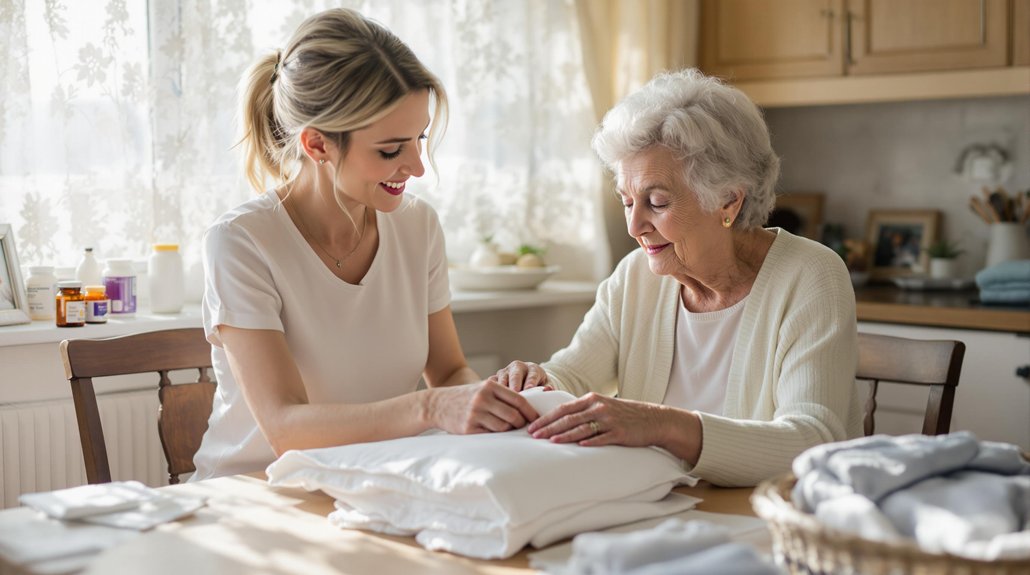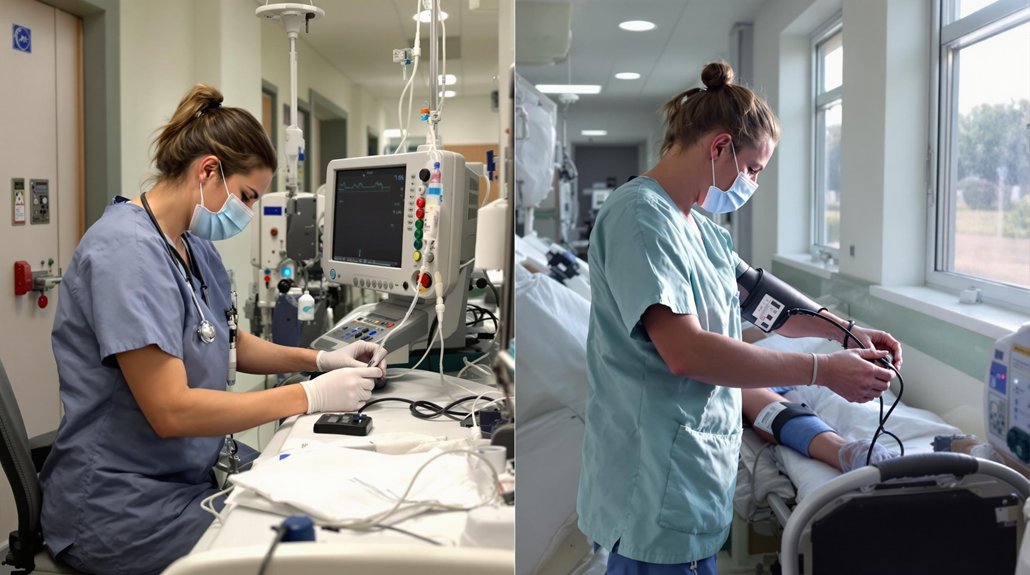Managing arthritis pain in loved ones requires an integrated approach focused on creating a supportive home environment with essential modifications like grab bars and non-slip mats. Low-impact exercises, properly timed with medications, help maintain joint mobility. Anti-inflammatory foods and proper nutrition support joint health, while professional caregivers provide specialized assistance. A thorough strategy incorporating these elements, along with appropriate medical supervision, offers the most effective path toward pain management and enhanced quality of life.
Key Takeaways
- Create a safe home environment by installing grab bars, non-slip mats, and proper lighting to prevent falls and support mobility.
- Encourage regular low-impact exercises and gentle stretching, timing activities with medication schedules for optimal pain management.
- Incorporate anti-inflammatory foods and maintain proper hydration while limiting processed foods to reduce joint inflammation.
- Organize frequently used items at accessible heights and provide assistive devices to support daily independence.
- Schedule regular sessions with professional caregivers trained in arthritis management for specialized support and therapy treatments.
Understanding the Daily Impact of Arthritis Pain
Living with arthritis presents significant daily challenges that extend far beyond occasional joint discomfort. For seniors managing this condition, persistent joint pain and stiffness can severely impact routine activities like dressing, preparing meals, or maintaining personal hygiene.
These physical limitations often lead to emotional struggles, particularly when independence becomes compromised.
The daily challenges of arthritis manifest through decreased mobility, chronic fatigue, and difficulty performing essential tasks. Understanding these impacts is vital for providing appropriate support and implementing effective management strategies.
Recognizing both the physical symptoms and psychological effects enables caregivers to develop thorough approaches that address the full spectrum of arthritis-related challenges.
Creating a Safe and Supportive Home Environment
A well-designed home environment plays a fundamental role in managing arthritis symptoms and supporting independent living.
Safety assessments identify critical areas requiring modifications to prevent falls and enhance accessibility. Essential home modifications include installing grab bars in bathrooms, raising toilet seats, and adding non-slip mats in high-risk areas.
Proper lighting, removal of tripping hazards, and reorganization of frequently used items to accessible heights further support mobility.
Strategic placement of supportive equipment and assistive devices throughout the home enables individuals with arthritis to maintain independence while reducing joint strain during daily activities.
Qualified caregivers can assist with implementing and maintaining these safety measures while providing compassionate support for daily activities.
Exercise and Movement Strategies for Pain Relief
Regular physical activity remains essential for individuals with arthritis, despite the challenges of joint pain and stiffness. Low-impact exercises, particularly gentle stretching and range-of-motion movements, help maintain joint flexibility while minimizing stress on affected areas.
Aquatic therapy provides an ideal environment for arthritis management, as water’s buoyancy reduces joint pressure while offering natural resistance. Activities like water walking and swimming strengthen muscles without excessive joint strain.
Healthcare professionals recommend starting with short exercise sessions, gradually increasing duration as tolerance builds. Incorporating chair-based exercises and modified yoga poses can enhance mobility while maintaining joint stability.
Exercise timing should align with medication schedules for optimal pain management.
Nutrition and Dietary Approaches for Joint Health
Proper nutrition plays a fundamental role in managing arthritis symptoms and supporting joint health. A diet rich in anti-inflammatory foods, including omega-3 fatty acids, antioxidants, and essential minerals, can help reduce joint inflammation and discomfort.
Berries, leafy greens, fatty fish, and nuts provide natural compounds that support cartilage repair and reduce inflammatory markers.
Joint health supplements, such as glucosamine, chondroitin, and vitamin D, may offer additional support when recommended by healthcare providers.
Maintaining adequate hydration and limiting processed foods high in saturated fats and refined sugars helps optimize the body’s natural inflammatory response and promotes overall joint function.
Professional Care Support Options for Your Loved One
When managing chronic arthritis becomes increasingly challenging, professional care support services offer extensive solutions that enhance quality of life while maintaining independence at home.
Licensed caregivers with specialized training provide thorough assistance, including medication supervision, mobility support, and daily living activities.
Professional caregivers undergo rigorous caregiver training in arthritis management techniques, ensuring optimal care delivery. They provide essential emotional support while monitoring symptoms and implementing pain management strategies.
Services can be customized to individual needs, ranging from part-time companionship to full-time care, with options for live-in assistance available through reputable providers like Health at Home.
Through skilled home care services, patients can access specialized physical and occupational therapy treatments to improve mobility and maintain independence in their familiar environment.
Essential Tools and Devices for Improved Mobility
Building upon professional care support, the right mobility tools and assistive devices can greatly enhance independence and reduce joint strain for individuals managing arthritis.
Essential assistive devices include properly fitted canes, walkers with shock-absorbing grips, and raised toilet seats to minimize joint stress. Grab bars strategically installed in bathrooms and hallways provide vital support during changes.
For daily activities, long-handled reachers, button hooks, and ergonomic utensils help maintain autonomy while protecting joints. Mobility aids such as shower chairs and bed rails further promote safety and independence.
These tools, when properly selected and implemented, greatly improve quality of life for arthritis patients.
Personal care assistance from trained caregivers can help ensure proper and safe use of mobility devices while maintaining dignity.
Building an Effective Pain Management Routine
A well-structured pain management routine forms the cornerstone of effective arthritis care at home. Establishing consistent timing for medication management, coupled with targeted pain relief techniques throughout the day, maximizes therapeutic benefits while minimizing discomfort.
The routine should incorporate scheduled activities: morning stretches to reduce stiffness, strategic rest periods between physical tasks, and evening relaxation protocols.
Heat therapy before activities and cold therapy afterward help regulate inflammation. Regular assessment of pain levels enables caregivers to adjust interventions accordingly.
This systematic approach, when implemented consistently, supports ideal joint function and enhances overall quality of life for individuals managing arthritis.
Licensed therapists can develop customized treatment plans that integrate therapeutic exercises specifically designed for joint pain relief and improved movement.
Conclusion
Managing arthritis pain in elderly individuals requires a multifaceted approach incorporating evidence-based interventions, environmental modifications, and professional support systems. Implementation of structured exercise protocols, dietary enhancement, and assistive devices demonstrates measurable improvements in pain management outcomes. Clinical evidence supports the integration of both pharmacological and non-pharmacological strategies, while regular assessment and modification of care plans guarantees peak therapeutic efficacy for long-term pain control and functional maintenance.





